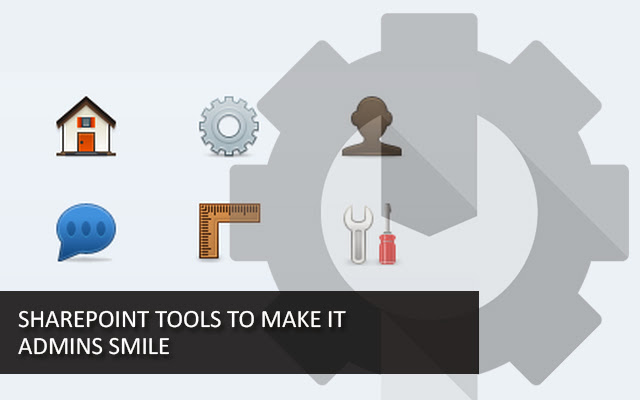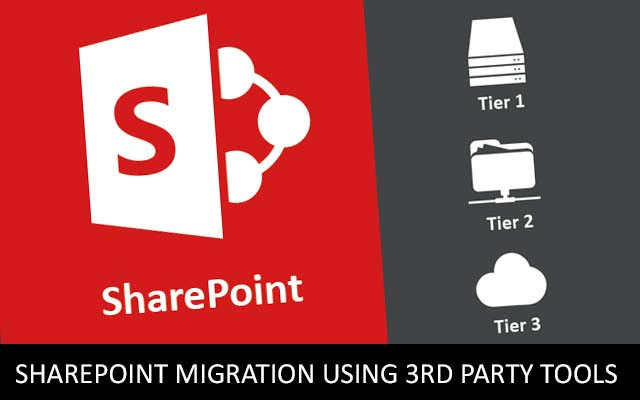SharePoint
is a rich tool and offers extensive features for a better, customized
and organized work flow. It enables to make processes easier and swift
that enables organizations to make the best out of their employees. It
is the best CMS that enables to manage huge amount of content
effectively.
We
live in a competitive world and latest technologies emerge to enable to
deliver the best results possible. SharePoint is Microsoft's tool that
enables to build richer attractive websites. It is considered to be the
most popular collaborative tool that provides all the necessary tools to
manage people and content effectively. This platform makes it easy for
employees of an organization to share ideas and engage smoothly in
knowledge sharing activities.
Some of the free tools which helps admins while customizing their websites are as follows:
Microsoft
bakes a bunch of nice things into this little add-on, including a kit
that generates test loads to check how well any SharePoint deployment
runs. It includes another important addon for the Security Configuration
Wizard so one can harden the profile of deployment through Windows
Server 2008. The SPDiag 3.0 utility is most useful. It grabs a heap of
statistics from all the servers in a SharePoint farm, interprets them
and presents them in a very neat and customized report.
2.ManageEngine's Free SharePoint Health Monitor Tool
For
smaller SharePoint deployment, this lightweight tool gives just an
overall rollup of SharePoint farm's health status at a glance. The
ManageEngine Free SharePoint Health Monitor fits this bill nicely,
giving a conveniently efficient dashboard view where one can see the
details about the memory, CPU and disk space usage for each server
running SharePoint.
It
can be drilled down into the SharePoint workload itself to see the
response time, service status, Web server (Internet Information
Services) process details and even SQL Server details such as buffer
cache hit ratio, cache memory and free pages.
3.IntLock's CardioLog Analytics Free Edition
If
systems have a quarter of a million page views or fewer per month, one
can use this free tool to help which finds out the sites employees are
using, how long they are typically engrosed with those websites and what
areas of those websites are most used. It installs quickly and is
compatible with all kinds of versions of SharePoint, even the latest new
SharePoint 2013. One can easily upgrade to the paid version where the
free edition has all of the same features, with the only differences
being the page view tracking limit and allowing for web-based support.
4.Microsoft's SharePoint Designer (for 2007, 2010 and 2013)
Designer
is like the FrontPage web design tool of the SharePoint world. One can
use it to customize the look and feel of SharePoint websites, create and
modify simple workflows and personalize a SharePoint deployment at
ease.
If
one have a large SharePoint deployment with multiple versions running
at the same time, one must use the Designer version specific to the
particular SharePoint edition.
5.Idera's Free SharePoint Admin Toolset
This
is a combination of seven tools in one, a site monitor is present to
check up on any SharePoint sites one manages, a space trends report to
track using disk space on deployment for folders, libraries and
websites, a handy accelerator that essentially rebuilds the database
indexes on the SQL Server instance managing SharePoint deployment, a
clean report to show how much SQL database space deployment is
consuming, a permissions analyzer to show what users can access which
specific websites and libraries, a smart tool to compare the
configurations of site collections to see where they are different and a
quick admin tool that brings together most frequently used links to
SharePoint Central Administration. A very smart tool set to make tasks
easier and smart way to deal with.
6.Idera's Free SharePoint Performance Monitor
To
have a detailed information at what is happening under the hood of any
SharePoint farm, this great tool Idera's Free SharePoint Performance
Monitor is used. This tool gives a holistic overview of the performance
statistics and metrics for SharePoint itself, the SQL Server instance on
any given server and information about the host's operating system and
memory configuration.
The
tool also can be configured to send simple e-mail alerts when one of
the performance indicators does not work. One can also monitor multiple
websites at a time for their deployments and one can generate nifty
graphs and charts about connections, requests, response time, pages,
disk usage and many more.
7.McAfee's Network Discovery for Microsoft SharePoint
It
is a good SharePoint-specific inventory tool. If one has overall
responsibility for a network, one might not even know if one of
departments has deployed a SharePoint server. The McAfee Network
Discovery Tool for Microsoft SharePoint will scan the network to find
SharePoint 2003, 2007 and 2010 environments and then display the results
of its scan in a nice neat HTML report that shows in detail which
servers have been deployed and what version they're running.
8.Axceler's ViewPoint for SharePoint
This
is a great tool for visualizing in a convenient table form exactly
which users have what permissions on any given site. This could be very
useful in an auditing scenario or any environment where permissions can
tighten without granting full access to users needlessly. One can choose
to work from the graphical dashboard, to run and print reports to
provide to management or to work through with any administrative tools.
It works with both SharePoint 2010 as well as SharePoint 2013
deployments. It even requires full SharePoint administrator permissions
to do its job properly.
9.Quest's Server Administrator for SharePoint
This
great tool is suitable on SharePoint 2007 and 2010. It lets to see
which parts of farm configuration are affecting the security,
performance and availability of deployment.
It
helps to build PowerShell scripts to maintain environment. It also
helps with a migration to SharePoint 2010 from 2007, required to get to
SharePoint 2013 as well, by showing which parts of deployment are ready
for the upgrade and which are not. And it provides an intelligent rating
to show what is most important to upgrade before one begin against what
would simply be "nice to have."
10.SharePoint SUSHI
SharePoint
SUSHI is an open source project hosted on CodePlex that essentially
takes the most common administrative tasks and puts them in one
convenient tool. SUSHI, which bills itself as a "Swiss army knife for
SharePoint," stands for SharePoint Utilities with a smart and useful
interface.
One
can view the lists and sites of any given user can access, which is
really helpful for looking at effective permissions, upload user photos
as profile images, back up and restore sites; apply a theme to a group
of sites with one click and much more.
11.Clockwork Software
It
is SharePoint Migration Tool, reliable migration of documents from old
ECMS to SharePoint 2010 or SharePoint 2013. From any SQL Server based
ECMS (EDRMS, DMS, CMS) with files stored on a network drive or share.
ECMSs such as Hummingbird DM6, DOCs Open, Worksite, FileNet etc.
- Migrate all versions and metadata (including managed metadata)
- Migrate to SharePoint libraries and folders
- Apply document level security if desired
- Currently in use on migration projects totalling about 2 million documents
- Good for small migrations with a cost effective pricing scheme.
12.Metalogix
It
can migrate content into SharePoint from just about any source system.
From one SharePoint version to another (2003, 2007, 2010, WSSv2 or
WSSv3), from various Enterprise Content Management systems (eRoom,
Stellent, Livelink) and from file systems, exchange public folders,
blogs and websites.
13.PCVITA Express Migrator
It
is SharePoint comprehensive too designed for enterprise to migrate
content to SharePoint as part of SharePoint migration strategy that goes
above and beyond other traditional SharePoint migration software,
thereby allowing to have visually architected migration. It provides an
effective and simple solution for enterprise to migrate their
business-critical data from different repositories (Lotus Notes, File
Share, File System, Public Folder and SharePoint etc) to Microsoft
SharePoint Server. The SharePoint migration product granularly migrates
content while keeping all the associated metadata & permission
intact.
14.Vyapin
A
powerful tool for developing SharePoint application for migrating
documents, NTFS permissions, data and their associated metadata
properties from network file shares, file servers and local hard drives
to Microsoft SharePoint 2013, Office 365 (SharePoint Online), SharePoint
2010 and SharePoint 2007.
Here
are the list of functions it provides such as migrate folders and files
into SharePoint libraries from various file servers and network shares.
Carry forward default file properties, including custom Office document
properties to the respective documents in SharePoint. Automate entire
migration process, with the ability to correct and rectify migration
errors using the pre-migration validation tool. Migrate content from
file shares to on-premise SharePoint servers and SharePoint Online in
Office 365 (Standard) environment using a single application.
15.Tzunami
This
Deployer tool offers a cost-effective solution for migrating and
consolidating multiple content sources into SharePoint. It supports
almost all versions of SharePoint, from SPS 2001 to SharePoint 2013.
Automating the entire process of migrating unstructured content.
SharePoint
offers multiple benefits for enterprises big and small. It is for this
reason that enterprises are stressing on this particular technology for
enabling them to function optimally. It enables to increase employee
productivity and enables them to remain more focused with their work. It
can function as an effective content management system, document
management tool and collaborative platform. Businesses have profited
much more with this awesome tool and it has enabled to enhance business
initiatives. SharePoint development services are frequently used to reap
maximum benefits.







